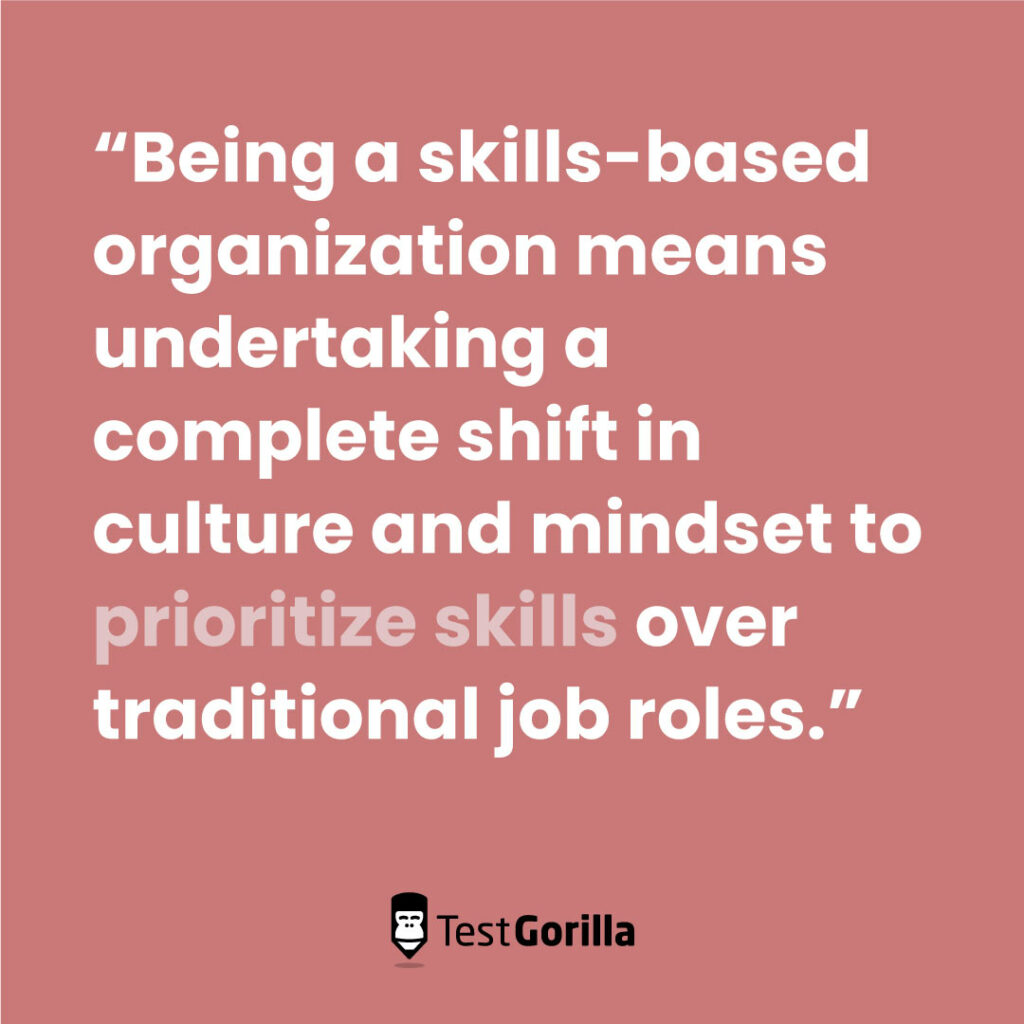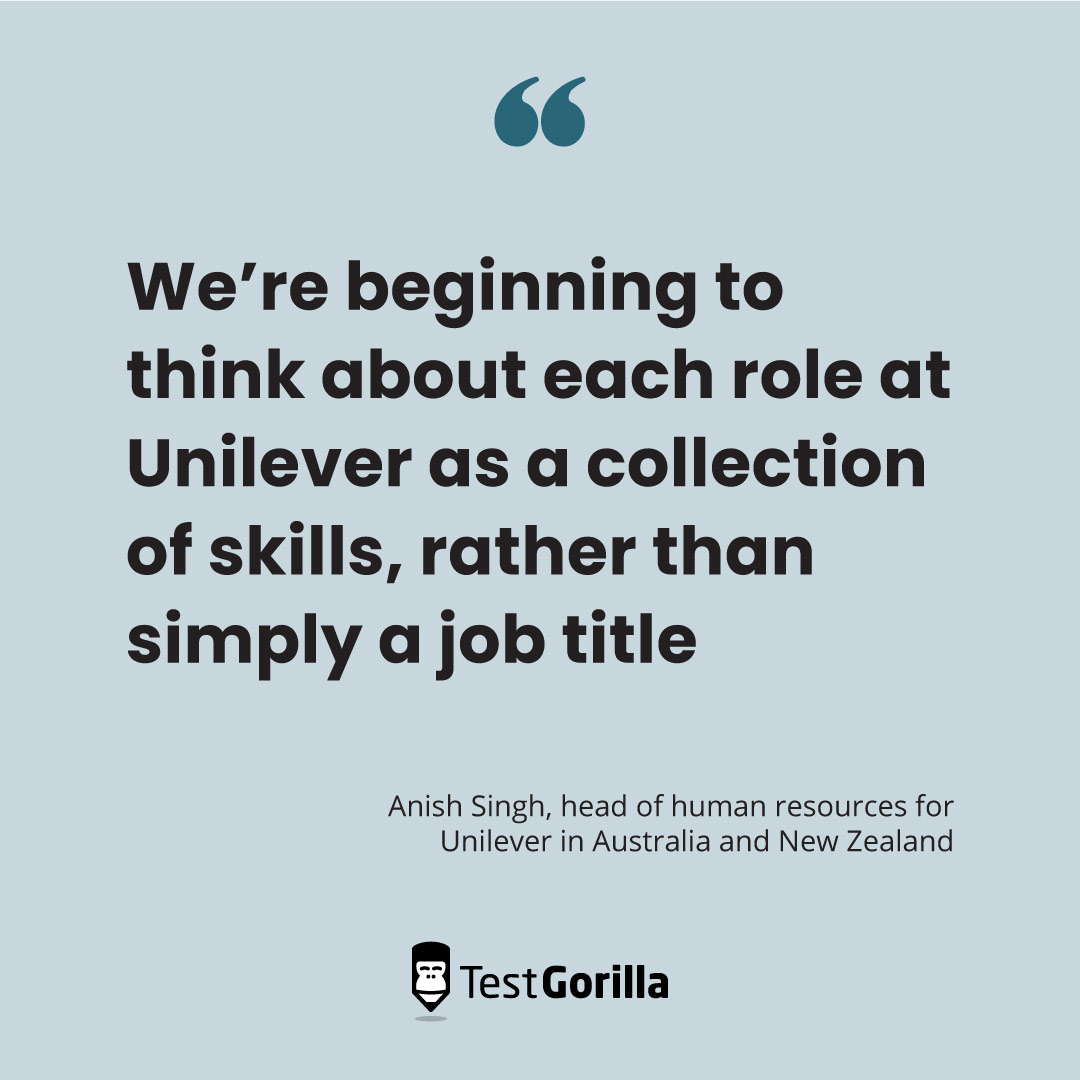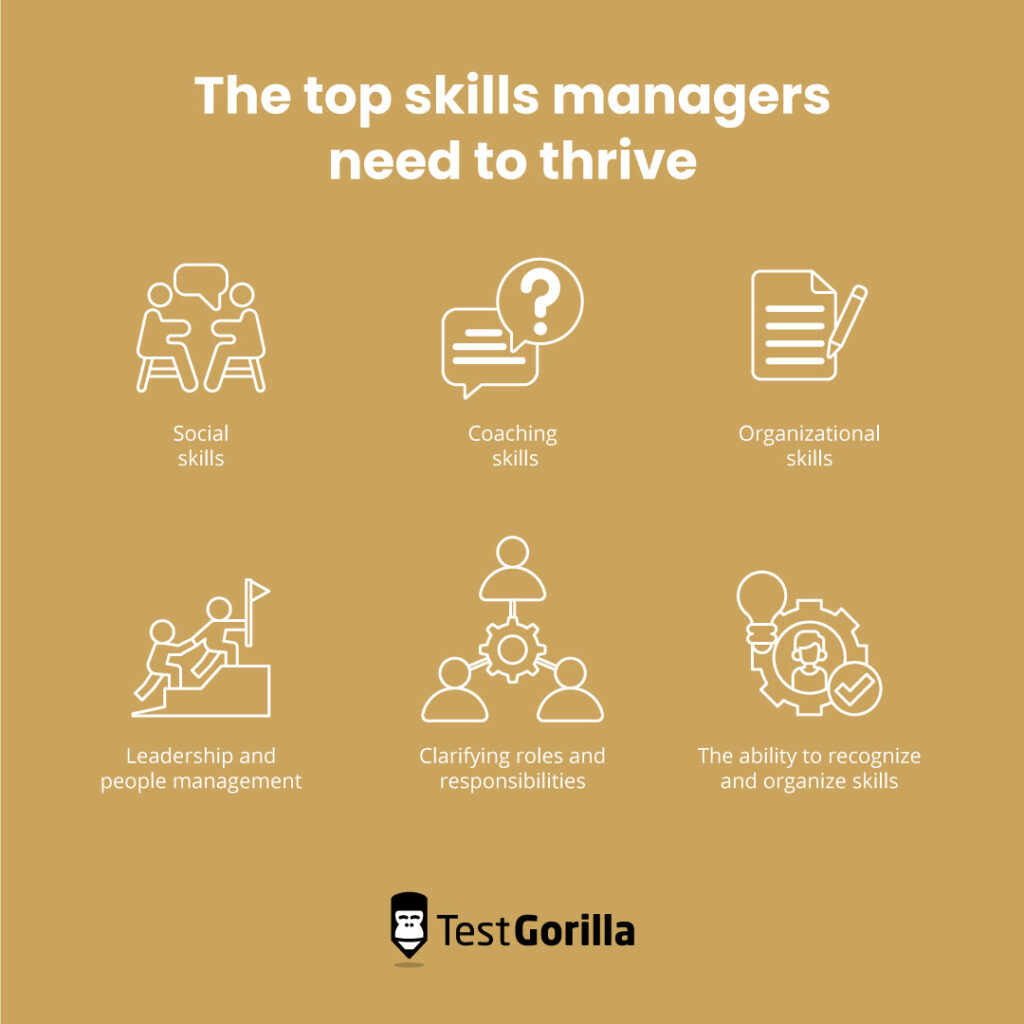The changing role of managers and management in skills-first organizations
Traditional company leadership is centered around managing specific job roles: determining salaries, providing guidance, and monitoring performance.
But what do leaders and managers do without strict job roles? What would their primary responsibilities be?
Skills-first organizations prioritize skills over traditional job roles and structure, instead organizing responsibilities and making decisions based on capabilities, not a strict hierarchy.
According to TestGorilla’s State of Skills-Based Hiring report, 76% of businesses are using skills-based hiring. This means many companies are on their way to becoming skills-first organizations.
So what does that mean for managers? Will leaders have new roles and responsibilities in a skills-first company?
The short answer is yes. These changes will be substantial, but they’ll be gradual, steady, and for the betterment of the company.
Let’s explore the changing roles of managers and management in a skills-first organization, what you can expect, and how to adapt.
Table of contents
- What is a skills-first organization?
- Why will the roles of managers change in a skills-based organization?
- What will senior leaders look like in skills-first organizations?
- What will middle managers look like in skills-first organizations?
- Will the natural transition from employee to manager be disrupted?
- Get management on the path to building a skills-first organization
- Source
What is a skills-first organization?
A skills-first organization uses skills as the basis for how a company is structured, how decisions are made, and how responsibilities are completed.
This is different from a company simply having skills-based hiring practices, although skills-first organizations have those as well, of course.
Being a skills-based organization means undertaking a complete shift in culture and mindset to prioritize skills over traditional job roles.
Maurice Jones, the former CEO of OneTen, describes a skills-based organization as a company that prioritizes skills as the dominant factor for success. Employers translate jobs into the skills needed to complete them, not credentials and experience.
Skills-first organizations don’t use rigid and specific job roles for their work like a traditional company.
Here’s a comparison of the two with a sample job role:
Role | Traditional organization | Skills-first organization |
Junior marketer | Completes their list of tasksNever deviates or extends to other dutiesCompletes the same tasks as every other junior marketer | Completes many typical junior marketing tasksHelps with sales tasks a few times a week because they’ve proven themselves capableHas different responsibilities than other junior marketers to match talent level |
Skills-first organizations don’t stick to fixed job roles with a set list of duties. They focus more on problems to be solved, outcomes to be attained, and value to realize. This also means a greater focus on tasks and projects than traditional jobs.
Anish Singh, the head of human resources for Unilever in Australia and New Zealand, said it well:
“[W]e’re beginning to think about each role at Unilever as a collection of skills, rather than simply a job title”
This practice enables employees to do what they’re best at, no matter where their skill sets are. Our example above showed that an employee in a skills-first organization is able to use both their marketing and sales skills in a single job role.
And the possibilities only expand from here, for skills-based organizations also prioritize learning, development, and internal mobility.
This means that our junior marketer could develop their skills further, take on more responsibilities, and move on to more advanced roles.
The shift to a skills-first mindset is substantial for companies, so it’s only natural that managerial roles and responsibilities are going to change.
Let’s talk about it.
Why will the roles of managers change in a skills-based organization?
Traditionally, work was confined to standardized tasks in structured job roles. All decisions made were based on those roles and an organizational hierarchy.
This structure is counterproductive to essential modern goals such as:
Company agility
Continued growth
Innovation and creativity
Flexibility
To achieve these ambitious goals, managerial positions need to be reorganized and restructured.
For example, according to Deloitte, 80% of business executives say that, in order to reduce bias and improve fairness, you need to base decisions about hiring, pay, promotions, succession, and deployment on people’s skills rather than their job history, tenure in the job, or network. This requires managers to change their perspective and approach.
Let’s take a deeper look at this gradual transformation for senior leaders, middle managers, and future leaders.
The best insights on HR and recruitment, delivered to your inbox.
Biweekly updates. No spam. Unsubscribe any time.
What will senior leaders look like in skills-first organizations?
Senior managers will occupy a similar position in skills-first organizations; however, they must be ready to change their mindsets, visions, and public stance.
How will their roles change?
Senior leaders in a skills-first organization are responsible for the cultural transformation of the organization.
This means their roles will be centered on:
Ensuring their workforce understands what a skills-based organization is
Ensuring everyone knows why it’s important to work this way
Encouraging company-wide understanding and alignment
Driving a skills-based culture and having courage in their convictions
Senior leaders in a skills-based organization need to be staunch in their beliefs and think more about innovating beyond traditional processes, not just sticking to the status quo.
It’s also crucial that senior leaders take skills-based practices seriously. For a skills-first organization to thrive, senior leaders need to treat these practices like a business priority.
What will be their key objectives?
The key objectives for leadership in a skills-based organization are prioritizing skills, promoting growth through talent development, and communicating these new goals internally and externally.
The biggest challenge that senior leaders face is implementing skills-based practices in the first place. Instilling these new beliefs and ensuring their people understand them are crucial to a skills-first organization’s success.
These changes cannot simply be ordered into effect. They take patience and a deep understanding of the “why.”
A senior leader’s communication ensures everyone is open to changing these processes and welcoming a skills-based system. You need every employee and stakeholder’s support to adopt a healthy skills-based culture.
This means that leadership has to stand by their new organizational culture and wear their vision on their sleeve.
Another objective to be had by senior leaders in a skills-first organization is introducing new metrics and goals that reflect their new skills-based system. For example:
Have 75% of employees complete upskilling plans this year
Have all new engineering hires score over 80% in their assessments
Implement skills-based hiring practices in 60% of available roles
Have 70% of promotions be judged with skills-based metrics
While ideally, you might want your workplace to be 100% integrated with this skills-first philosophy, that’s not always practical for transitioning organizations. Baby steps might be necessary, and that’s okay!
Goals like these not only help further your skills-based objectives and values but also loudly communicate your practices to everyone involved. It shows your people that you’re committed to a skills-based system and that it’s not just a trend.
What will middle managers look like in skills-first organizations?
We’ll start by saying something right off the bat: Managers won’t become obsolete, and they have an essential role in any skills-based company.
In a skills-based organization, managers’ roles shift from managing specific job roles to dynamically organizing work and skills for tasks and outcomes to be achieved.
This means talent sharing is essential: Sharing talent across departments and teams rather than hoarding it for their own team is part of a healthy, skills-based, company-first mindset.
Managers also define job responsibilities and align the right skills to them, determine how work is done through thoughtful experimentation, provide resources and support, and help workers build their skills and grow.
How much will their role change?
A manager’s role will change quite a bit.
Much of a manager’s job is centered around specific job roles, which means the following will experience a transformation:
Writing job descriptions: Managers need to carefully study job roles to determine what’s essential when skills-based job descriptions require a focus on capabilities and responsibilities over history or education
Setting compensation and benefits: Managers need a new way to base compensation based on skills and performance rather than seniority and tenure
Assigning training: Managers need to monitor performance, identify opportunities for upskilling and reskilling, and assign training dynamically to those who need it
Hiring: Managers need to adopt skills-based hiring practices, which means using skills tests, unstructured interviews, and job trials
Giving feedback: Managers need to give regular, consistent feedback to ensure employees have ample opportunity to grow and improve
Promoting: Managers need to base growth and promotions not only on skills, but on the career path the employee may desire
Organizing team responsibilities: Managers need to fluidly organize and assign responsibilities based on skills, which could even be cross-departmental
Much of management is centralized and structured around strict job roles, so these processes have to shift to be skills-focused to be effective.
Middle managers won’t be strictly monitoring and regulating roles, which means that other role-related duties change.
Performance management is one of these responsibilities.
Performance feedback and key performance indicators (KPIs) cannot be the same for all employees with the same job title and now need to be skills-based.
Skills-first managers must determine clear criteria that indicate employees are ready for growth or a new role, and they have to communicate these criteria with their people.
This is best done during talent reviews and regular 1:1 meetings. Managers should communicate how employees are demonstrating the right skills for the growth they want or give them feedback on how they can start achieving these goals.
What will be their key objectives?
A high-level overview of a manager’s objectives in a skills-first organization is to understand skills, facilitate the adoption of skills-based practices, and help their workforce grow.
Let’s go into these goals more deeply:
Understanding the skills their workforce possesses: Understanding the skills their workforce has or lacks is essential, which means conducting regular skills gap analyses
Adopting new practices and technology: Developing a new status quo is essential for managers, such as setting new goals, starting new programs, and approving new HR technology
Helping their people grow and learn: Building employee skills and helping career growth is important for every manager, but it’s non-negotiable for a manager in a skills-first organization
Facilitating career growth is unfortunately not as common as it should be. According to a survey by Degreed and Harvard Business Publishing Corporate Learning:
Only 40% of workers agreed that their manager helps them understand what skills they need to advance their careers
22% of workers said their managers do not encourage learning at all
17% said their managers help create a plan or set goals for developing skills
This lack of support is already a detriment to a healthy company, but it simply can’t happen in a skills-based organization.
Managers in a skills-based organization need to provide consistent, personalized coaching. This mentorship needs to be from person to person rather than standardized coaching for a specific role.
We believe this is a move that companies should have made ages ago since the “one-size-fits-all” approach doesn’t work – employees are all different, so coaching should be, too.
Middle managers need to be checking in with employees, asking them what they enjoy or don’t enjoy doing, what skills they want to develop, and asking their thoughts on where in the company they believe they’d flourish.
They should take the time to sit down with their people, ask about their career goals, and help them build a thorough, actionable professional development plan.
This is linked to the concept of servant leadership: Leaders and bosses serve their people before themselves and believe their goal is to empower their workforce to succeed.
According to an extensive study, an employee’s happiness and job satisfaction were much higher when they had a partnership with a leader versus a usual “boss” relationship.[1]
This type of manager is what makes leadership one of the top job satisfaction factors.
What skills do they need to learn to prepare for this transition?
This part isn’t going to change too much.
Managers need the same core skills as they do in a traditional company structure, but with a more skills-focused understanding.
Here are the top skills managers need to thrive:
Social skills
Coaching skills
Organizational skills
Clarifying roles and responsibilities
The ability to recognize and organize skills
These skills make middle managers much like project managers – arranging, organizing, and deploying skills to complete tasks. They may also need to manage cross-departmental or cross-organizational workers.
This means that learning how to manage an internal talent marketplace is an essential skill for skills-based managers and enables them to fluidly move and scale their workforce.
Internal talent marketplace: HR software where employees can input their skills and receive information on possible new roles they might be suited to.
Learning to use skills-based hiring practices and the associated tools are also crucial skills for these managers. Many employers cite that their biggest hurdle to adopting skills-based hiring is being able to properly validate the applicants’ skills.
For our in-depth guide on leadership skills, read our guide on management skills leaders need.
Will the natural transition from employee to manager be disrupted?
We first need to break down the concept of a “natural transition from employee to manager.”
What a traditional organization calls a “natural transition” isn’t so natural for many people. Some employees move into management for advancement and better compensation even though it’s not in their nature or personal goals to become one.
Skills-first organizations want to address this issue directly. Employees should be matched with a role that supports their skill sets, not just “whatever is next on the career ladder.”
Instead of a traditional hierarchy, skills-first organizations have a naturally evolving structure based on real skill and capability.
Here at TestGorilla, we have two main career ladders:
The management ladder
The individual contributor ladder
Our management ladder is similar to traditional advancement, but the individual contributor (IC) ladder is much different.
As an IC, you do what you do best, but you can get promoted and better compensated the more skilled and specialized you get.
A skills-based career ladder system just makes sense. Many employees have vastly different skill sets than managers, and with the gradual introduction of skills-based pay and more fluid positions, many subject matter experts might decide never to make the jump to management.
Management is a skill and should be treated like one – not just the “next rung” for anyone who’s worked for an organization for a long time.
Too many are considered “bad managers” simply because the position doesn’t suit them. One study found that 84% of American workers say that poorly trained managers create unnecessary work and stress.
How many managers struggle in their positions because they never wanted to have these responsibilities? They simply wanted better compensation and more recognition and management was the only option. This system is creating better, happier managers.
So, who does the managerial duties?
Many companies still have typical managers and simply treat management as a skill to learn and achieve. But in some skills-first organizations, many managerial responsibilities are distributed throughout the workforce or given to some workers as a temporary duty.
So how do you handle it? Here are a few tips:
Upskill or reskill interested workers, no matter what their background is
Create a workforce with many employees that share these responsibilities
Create two career ladders and allow employees to choose their paths
Check in with junior hires during one-on-one meetings and performance reviews and ask them about their ideal paths. Do they see themselves progressing into management, or would they prefer to develop as an individual contributor?
Skills-based organizations introduce a greater element of agency to their employees. Their career paths can be as diverse as they want them to be.
When managers support their people in a skills-based company and give them solid upskilling and reskilling opportunities, employees have limitless development potential.
Get management on the path to building a skills-first organization
Leadership and management will certainly change in a skills-first organization. Their objectives center around developing a skills-based culture, supporting their people’s growth, and aligning their workforce’s skills with the right responsibilities.
These changes are steps to creating a stronger, more equitable organization. With a little patience, these new roles and responsibilities will be a normal part of the job.
For more on managerial and leadership skills, read our guide on how to be a good manager (and how to hire one, too).
Try our HR Management test in your next pre-employment assessment to evaluate a candidate’s abilities to mitigate risk, drive positive employee outcomes, and guide stakeholder decisions.
Source
Helliwell, John, et al. (October, 2018). “Happiness at Different Ages: The Social Context Matters”. National Bureau Of Economic Research. Retrieved March 29, 2023. https://www.nber.org/system/files/working\_papers/w25121/w25121.pdf
You've scrolled this far
Why not try TestGorilla for free, and see what happens when you put skills first.





















